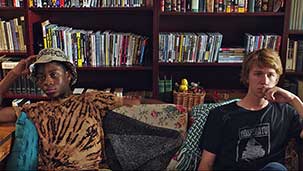When you are seventeen, one of the most useful clues to who you are is your bedroom. If I were a psychologist and I wanted to understand exactly what made someone tick at that point in their lives, I wouldn’t interrogate them, I would go through their stuff.
Me and Earl and the Dying Girl is a film about exactly that. The Me in this case is the requisite awkward teenage boy—Greg—played by Thomas Mann. He is both the self-avowed unreliable narrator and that rarest of things—a quirky teen who doesn’t immediately put me to sleep.
The film is primarily concerned with Greg and his interaction with both Earl (CJ Cyler, Greg’s film making partner and much less angst-ridden confidant) and the Dying Girl, Rachel (Olivia Cook).
Following a year or so in the life of Greg, Me and Earl and the Dying Girl begins with his first awkward interaction with Rachel. It also depicts Greg’s mostly unsuccessfully attempt to navigate the transition between the end of his prison term in the worst of all institutions, high school, and the wide unknown world to come. But the heart of the film is the short relationship between a miserable, self-absorbed asshole (Greg, representing every sixteen year old boy everywhere) and an afflicted young woman.
Olivia Cook as Rachel, a young women suffering from leukemia, manages to avoid melodrama in an impressively authentic, lived in performance. As well as that solid central performance, the filmmakers also managed to circumvent all of the usual tropes usually found at the centre of this genre. Clichés like the doomed romance, ageless wisdom from a person without any real life experience, the almost painfully stoic forbearance of a ridiculously cruel fate—are either subverted or ignored altogether.
Much of the film takes place in Rachel’s bedroom as she progresses through the various stages of her disease. This is a film that spends a lot of its time in rooms that are filled with the ephemera of their owners, and it is the reason why you are so important to the success or failure of this film, Gerald.
I believed this movie. I believed the people, the places, the minute detail that informed each room—the little visual details that make up someone’s life as they grope toward some kind of understanding of who they are, and what they care about. Those details were all up there, on the screen.
There is also an interesting nod to Michael Gondry (especially his Be Kind, Rewind) that anchored the film and these characters for me. It implied a particular sensibility and gave the audience a through line that smartly managed to connect almost all of the characters. It is those kinds of touches, along with some strong supporting performances (especially Molly Shannon and Nick Offerman) and a good script. These, plus quiet and assured direction from first timer Alfonso Gomez-Rejon, all raise this film far above what could’ve been just a hackneyed tear-jerker.
But it was the closing scene and a discovery that Greg makes in one of your rooms, a moment whose seed was planted in such a clever way early in the film, a moment so well executed and thoughtful that it elevated this film from good to memorable.
And it was one of those small details, hiding in plain sight, that only means something if you bother to look.
Nice work, Gerald.
Sincerely,

Tim







